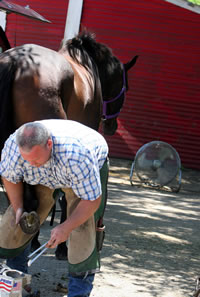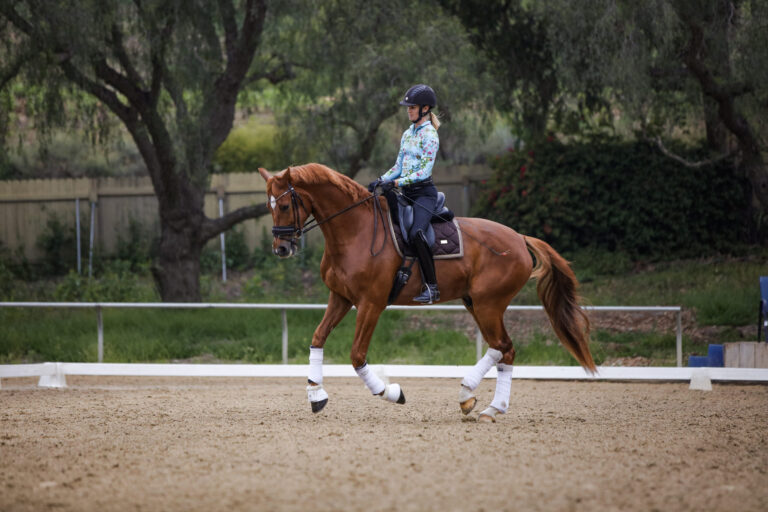Flies–annoying pests? An understatement, at best. Not only do these adversarial insects bite, buzz and sting, they also spread disease.

The reality is that flies are enemies that come with horsekeeping, and you’re not going to be able to take down every single one. But you can educate and arm yourself on ways to put them into retreat. We’ll provide anti-fly management tips to help you reinforce your battlefield, and then we’ll deliver specifics on six weapons of mass destruction. We’ll help you identify some of the other side’s troops as well. Time to wage war…
First Line of Defense
Before we survey the heavy artillery, implement the following management tactics to make your facility the least hospitable to flies.
Control moisture. Insects are drawn to wet areas, where they breed as well as drink. Keep stalls dry; eliminate standing water in low-pasture areas and in such receptacles as old tires or feeders; create good drainage around your barn; repair plumbing leaks; cover rain barrels.
Manage/remove manure. Manure is the housefly’s meal of choice. (Despite its name, the housefly is a major horse-area pest. See “Enemy Troops” below.) Clean stalls, pens, and other confinement areas daily; if possible, completely remove manure to an off-site location once a week; or, cover manure piles with a heavy tarp or treat on-site for later removal.
Employ the power of air. For stalled horses, strategically place large fans in your barn–air blasts will keep flies at bay; for pastured horses, provide access to open, breezy expanses.
Keep flies’ foodstuffs under wraps. Dispose of garbage appropriately (enclosed under airtight lids); cover grains and other feeds securely.
Provide solace in the dark. Provide shade (some fly species avoid dark areas); turn off barn lights to avoid attracting flies and other insects.
Avoid unsavory neighbors. If possible, don’t pasture your horses next to cattle or other livestock; cow manure, especially, draws vicious horn and face flies.
Six Anti-Fly Weapons
Besides taking fly-control management steps, you have other ammunition at your disposal. Here are of six of the most effective fly-control weapons, along with particulars on each.
1. Topicals
(sprays, roll-ons, gels, shampoos)
Method: Make your horse less attractive to flies.
How they work: Serve as a contact repellent/vapor barrier to fend off flies. Topicals with natural (pyrethrums) and synthetic insecticides work to “knock down” or deter flies; products without insecticides repel via citronella and other oils.
Pros: Easy to find and use; convenient for on-the-road use, such as when showing or trail riding, or when horse is away from barn for schooling or on pasture.
Cons: Relatively short-lived, depending on product; if you frequently bathe your horse, or he sweats significantly, you’ll lose effectiveness.
Time factor: With lower-priced products, apply daily or directly before riding. For higher-end products, apply every five days to two weeks (see product labels for specifications).
Best when: Used in conjunction with feed-throughs or fly parasites, which kill flies at the larval stage.
Cost: Largely depends on product and type of application. In general: the lower the cost, the shorter duration of protection.
2. Barriers
(sheets, masks, boots)
Method: Outer protection/barrier for flies and other biting insects.
How they work: Fly sheets: Lightweight mesh protects horse from withers to rump; many also offer neck, chest, and belly protection. Fly masks: Protect critical facial areas; styles vary: some cover eyes only, some extend over ears, some down over muzzle. Fly boots: Cover sensitive skin on lower legs.

Pros: Mesh material prevents horses from overheating; many barrier-type products offer sun protection (good for horses with exposed pink skin); masks help prevent conjunctivitis; sheets also protect coats from dirt and sun-bleaching.
Cons: Some sheets don’t protect sensitive areas like the face and belly; applying and maintaining equipment requires some elbow grease; not practical if you’re the sole caretaker of more than a few horses; can be dangerous if herdmates pull/bite sheet or masks, or if horses are pastured in brushy or timbered areas.
Time factor: Minimal to medium: applying/removing sheets, masks, boots when necessary. (For horse’s comfort and visibility, it’s recommended to remove masks at night.)
Best for: Horses living in close proximity with cattle or other livestock that attract horn and face flies; horses boarded at a facility without a broad fly-control program. Masks with ear covers are also helpful in areas plagued by gnats.
Cost: Varies by manufacturer and model. In general: Masks: $10 to $20; with ear protection: $20 to $30. Sheets: $60 to $150. Boots: $40 to $60 for a set of four.
3. Traps
Method: Entrap (and kill) adult flies.
How they work: Many different types, but all use some variation of fly bait or attractant to lure flies onto sticky surface or into receptacle, where they die.
Pros: Can kill flies in specific areas without putting insecticides into the air; help manage adult flies missed by other fly-control methods.
Cons: Most traps only attract “filth” flies (house and blow flies), so you need to determine the types of flies you’re targeting. Houseflies are usually the biggest problem for horse owners; if you have stable flies, you’ll need a different type of trap.
Time factor: Depends on traps, but usually requires minimal set-up time. Some traps last for a season; others need to be replaced more frequently.
Best for: Almost all situations; useful regardless of other implemented methods, because traps control adult populations.
Cost: Depends on type you use; can range from 30 cents to $8 for simple sticky traps (not as effective, but less expensive), to $4 to $18 for attractant-type traps.
4. Barn Spray Systems
Method: Kills flies, mosquitoes, and other insects on insecticide contact.
How they work: Tubing system with attached misting nozzles runs throughout facility. Tubing dispenses fine droplets of fast-acting natural insecticide (pyrethrum) into air from an on-site reservoir. Insecticide is mixed with water and is sprayed for about 35 to 45 seconds. On average, a system sprays about six times a day.
Pros: Extremely efficient, effective. Minimal work, as dispensed automatically at regular intervals. Kills flies quickly, so they don’t survive long enough to develop or pass on immunities to the insecticide. Short-lived pyrethrum is environment-friendly, as it biodegrades within 30 minutes of spraying.
Cons: High initial cost; some horses/people are sensitive/allergic to chemicals; kills beneficial insects such as spiders; manure close to barn still provides breeding grounds for flies (can also install nozzles along outside of barn).
Time factor: Refill tank a few times a year.
Best for: Medium- to large-sized enclosed facilities with multiple horses. (Can use in open barns, but not as effective, especially in areas with high winds.)
Cost: Varies by manufacturer, installer, and size of facility. Once installed, average monthly usage is about a gallon per nozzle, which comes to about $5 per stall, per month.
5. Biological Warfare: Fly Parasites
Method: Kills developing flies.
How they work: Release fly parasites (tiny, low-flying wasps) near manure piles and other fly-breeding sites. The parasites use the fly pupa (cocoon) as a host, killing developing flies so they never hatch. Prevents new generations from maturing.
Pros: Stops flies before they emerge and reproduce; no chemicals involved; doesn’t kill beneficial insects; safe; low maintenance; parasites don’t bite or sting people/horses/pets.
Cons: Doesn’t affect water-breeding flies like horse and deer flies; if your neighbor doesn’t have good fly control, his flies can migrate to your facility; must replenish monthly, as flies reproduce nine times faster than parasites.
Time factor: Five days after receiving them, parasites will emerge from pupa as active wasps. After releasing them, can take up to 30 days for noticeable results, because parasites don’t affect flies that have already hatched. Best to release before flies become rampant. But, once in circulation, you’ll only need to release new parasites every three to four weeks.
Best for: More condensed facilities, but effective in almost all set-ups.
Cost: One to five horses: under $20 per month; six to 10 horses: under $30 a month. Prices quoted according to number of horses. You’ll need to release parasites monthly starting in early spring; in peak fly months (when temps are highest), release every three weeks.
6. Feed-Throughs
Methods: Prevents flies from hatching in manure.
How they work: Given with horse’s grain ration; passes through his system, into manure to prevent larvae and pupa from developing there.
Pros: Safe; easy to use.
Cons: Don’t kill adult flies; kills some beneficial microorganisms; ineffective if other horses in facility not on feedthroughs (horses also need to be fed separately to ensure all ingest complete dosage).
Time factor: Two to four weeks to see results; feed with horse’s daily rations from early spring to late fall.
Best when: Used in conjunction with fly traps and topicals; works for facilities of any size.
Cost: 30 to 50 cents a day, per horse. Save money by purchasing in bulk.
More Than Annoying
Flies have the potential to cause your horse more than discomfort. They spread such diseases as salmonella, vesicular stomatitis, pigeon fever, equine infectious anemia, and influenza. They can cause allergies, dermatitis, and eye ailments, such as conjunctivitis. Constant stomping can lead to loose or lost shoes, and can cause arthritis, ringbone, and other impact-related injuries.
Flies can even lead to weightloss, as their constant buzzing, landing, and biting interrupts a horse’s grazing time and prevents rest. They may cause injury as well, as insect-crazed horses attempt to escape their relentless bombardment.
Enemy Troops
Several hundred species of flies plague horses. But regardless of the species, annihilation of their breeding and feeding grounds is crucial.
The following six are among the most prevalent:
Stable fly: Bite by piercing horse’s flesh to feed on his blood. These are the bugging bugs that gnaw on horses’ legs, causing them to stomp, squirm, and flick their tails.
Housefly: With sponge-like mouths, houseflies feed on secretions, manure, and garbage; don’t bite, but suck up secretions around wounds and horses’ eyes, nostrils, and anus.
Face fly: Females feed on secretions around eyes and nostrils, and on blood from biting flies and wounds. They have sandpaper-like tongues that abrade eye-area tissue to stimulate flow of tears (can cause infection, and even blindness).
Horn fly: Half the size of housefly; pierce horse’s skin to suck blood; prefer cattle, but attack nearby horses; can fly up to 10 miles, but then stay with same animals for the rest of their lives.
Bot fly: Lay sticky eggs on horse’s haircoat and on muzzle, jaw, lips, throat, and insides of legs. Larvae hatch in horse’s mouth and later migrate to and live in his stomach and intestines; can cause poor condition, and even death.
Gnat: Also known as “no-see-ums”; size of pepper grain; painful bites can cause sweet itch (persistent skin break-out that itches fiercly); itchy, crusty sores can cause horse to rub off patches of hair; most bothersome at dusk and dawn.











